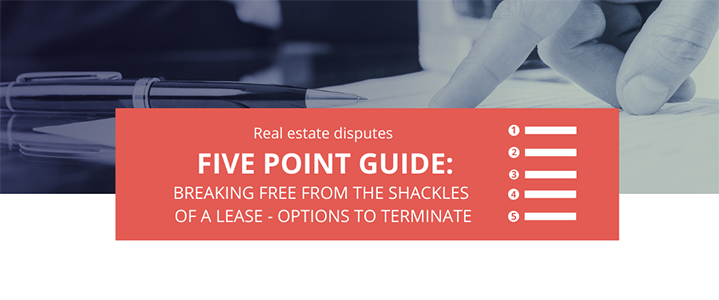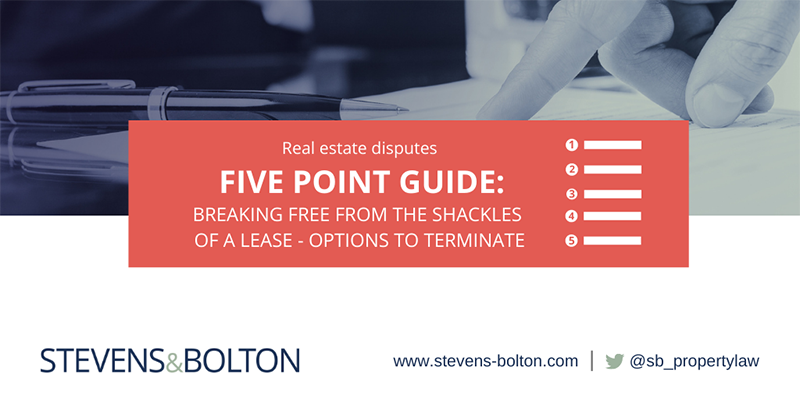 Tenants’ property requirements are changing. A survey recently undertaken by the Institute of Directors claims that nearly three-quarters of firms will maintain home-working during the COVID-19 pandemic, with more than half planning to reduce their long-term use of workplaces. Break options offer tenants a way out if they are exercised properly.
Tenants’ property requirements are changing. A survey recently undertaken by the Institute of Directors claims that nearly three-quarters of firms will maintain home-working during the COVID-19 pandemic, with more than half planning to reduce their long-term use of workplaces. Break options offer tenants a way out if they are exercised properly.
As property is often the single largest overhead for an occupier, tenants are having to find ways to rationalise their operations and, if necessary, extricate themselves from onerous leases to keep costs down. But during an economic downturn, landlords are less likely to be willing to allow tenants to leave early. So, unless tenants have contractual options to terminate their leases, they will struggle to break free from their shackles. The following five points serve as a timely reminder to landlords and tenants whose leases may contain such break options.
- A break option is often negotiated into leases to offer a tenant flexibility to terminate on a specific date, or on a rolling basis. In the current market, unless a landlord is keen to recover possession of the property, a tenant should expect its landlord to scrutinise and potentially challenge any attempt it makes to break the lease early.
- Drafting and serving break notices correctly and in accordance with the lease is not always easy. A tenant should always consider seeking specialist legal assistance, especially where there is a one-off break opportunity as this often offers no room for error. The risk to a tenant is even greater where the break option is conditional. Often break options require the tenant to have satisfied certain pre-conditions by a specific point in time, either by the date the notice is served, or by the break date itself. Failure to satisfy these pre-conditions will invalidate the break.
- The new RICS code for leasing business premises, effective from 1 September 2020, recommends that break options should only be conditional upon the payment of basic rent and the giving up of occupation leaving no third party occupiers. However, in reality, most break options contain more onerous terms, which often catch tenants out. For example, a common pre-condition in break options requires a tenant to pay all sums due under the lease by the break date. Depending on the wording of the lease, there may be other sums due, in addition to basic rent. The tenant will therefore need to review its lease covenants very carefully and carry out a thorough review of its payment history to ensure all payments have cleared by the break date. There is no de-minimis rule that applies here, so failure to pay any sum outstanding however small, even if just a few pounds of interest, could be fatal to the break. Also, if the break date falls part way during a quarter, this will often require the tenant to pay a full quarter’s rent to satisfy the break condition. A well advised landlord may be able to use these onerous obligations to either challenge validity and keep the tenant on the hook, or to leverage a favourable surrender premium.
- The timing for payment of a break penalty, if one exists, can become an issue where a tenant’s cash flow is already tight and it wants to leave payment to the last possible moment. This is risky and a tenant should ensure that it pays in cleared funds, and if possible obtains confirmation of receipt, in good time ahead of the break date. Another potentially live issue may be whether or not the premium should exclude or include VAT. Each case will depend on their facts, and specialist tax advice should be sought.
- Unless a rent concession is properly documented, it could inadvertently waive a landlord’s right to enforce a break pre-condition which requires payment of rent. If parties agree as part of the concession that the rent is to be temporarily reduced, it is important to clarify whether the balance owed under the concession will also still be payable at the break date in order for the tenant to comply with the pre-condition. A landlord and tenant should therefore consider very carefully if there are any repercussions that the concession might have on the parties’ obligations under the lease. Otherwise parties could spend lots of time and money arguing later.
This note was prepared on 21 October 2020 and reflects the position at that point in time. Current guidance may of course change and up to date legal advice should always be taken on any relevant issue covered here affecting your business.

 Markus Klempa
Markus Klempa